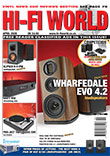Page 6 of 6
Measured by a Rohde&Schwarz UPV - the world's most advanced audio analyser
MEASURED PERFORMANCE The TX-NR3030 produced a massive 180Watts into 8 Ohms under test, and 290 Watts into 4 Ohms. It ran just warm under test but a cooling fan kicked in after a while. It was able to cope with delivering high power for a long period without getting too hot. Distortion levels were low, reaching a maximum of 0.018% at 10kHz, 1W output into 4 Ohms. This is low, and our harmonic structure analysis shows classic crossover distortion, but it is kept well under control. An analogue input signal, through the ADC caused overload above 2V, but this limit is avoided by selecting Direct to route around the ADC. ADC noise was low at -90dB; noise measured a low -102dB in Direct mode (no ADC). High input sensitivity of 220mV allows the Onkyo to accommodate external low gain phono stages for anyone wanting to run an MC cartridge perhaps; the phono input fitted is MM only. Onkyo always fit a good VHF/FM tuner and this one was no exception. Frequency response measured flat to 7kHz (-1dB), after which treble rolled away slowly to measure -1.5dB at 10kHz. The mpx filter imposed a sharp cut off at 16kHz to reject 19kHz pilot tone. This response will give a slightly warm or ‘easy’ sound balance. Distortion was unusually low at full modulation, measuring 0.1% against a usual 2%, so this may well be a SDR tuner; if so it is a good one. Hiss was low at -68dB (IEC weighted) at full quieting, from a modest 0.8mV (p.d.) from the aerial. Measured IHF 50dB stereo sensitivity was good at 34uV. The MM Phono input was accurate in equalisation, having flat frequency response across the audio band. With low noise, normal sensitivity and overload figures it performed well all round. Frequency response for CD through the D/A convertors via the optical S/PDIF digital input was absolutely flat, reaching 20.3kHz (-1dB). Distortion wasn’t so low, measuring 0.27% at -60dB - not a great result for 16bit where 0.2% is common. With high resolution digital (24bit PCM) just 0.06% distortion was measured at -60dB, a good result, so on balance the ‘3030 is no disgrace. Surprisingly, neither electrical nor optical S/PDIF digital inputs would accept a sample rate higher than 96kHz, the receiver remained silent when fed 176.4kHz or 192kHz digital, a peculiar and significant limitation nowadays. The TX-NR3030 measured very well in most areas. The VHF tuner is a very good one, giving fine results all round. With CD (16/44.1 PCM) digital input performance figures were good, as is to be expected nowadays. Inability to handle high resolution PCM above 24/96 was a surprise but 24/96 bandwidth and linearity were good enough to reveal sound quality improvement over lower resolution digital. NK
FREQUENCY RESPONSE
DISTORTION
Power 180W Frequency response (Direct) 6Hz-100kHz Separation 83dB Noise (A/D, Direct) -90/-102dB Distortion 0.02% Damping factor 25
DIGITAL Frequency response (-1dB) 4Hz-41kHz (24/96) Separation 102dB Noise -112dB Dynamic range (EIAJ) 112dB Distortion (-60dB) 0.06%
VHF TUNER Frequency response 20Hz-7kHz Stereo separation 56dB Distortion (50% mod.) 0.08% Hiss (CCIR) -68dB Signal for minimum hiss 0.8mV Sensitivity (stereo) 34µV
PHONO Frequency response 6Hz-20kHz Stereo separation 68dB Distortion (50% mod.) 0.04% Hiss -82dB Sensitivity 4mV Overload 70mV
|
Search
Hi-Fi World, Powered by Joomla!; Hosted by Joomla Wired.









